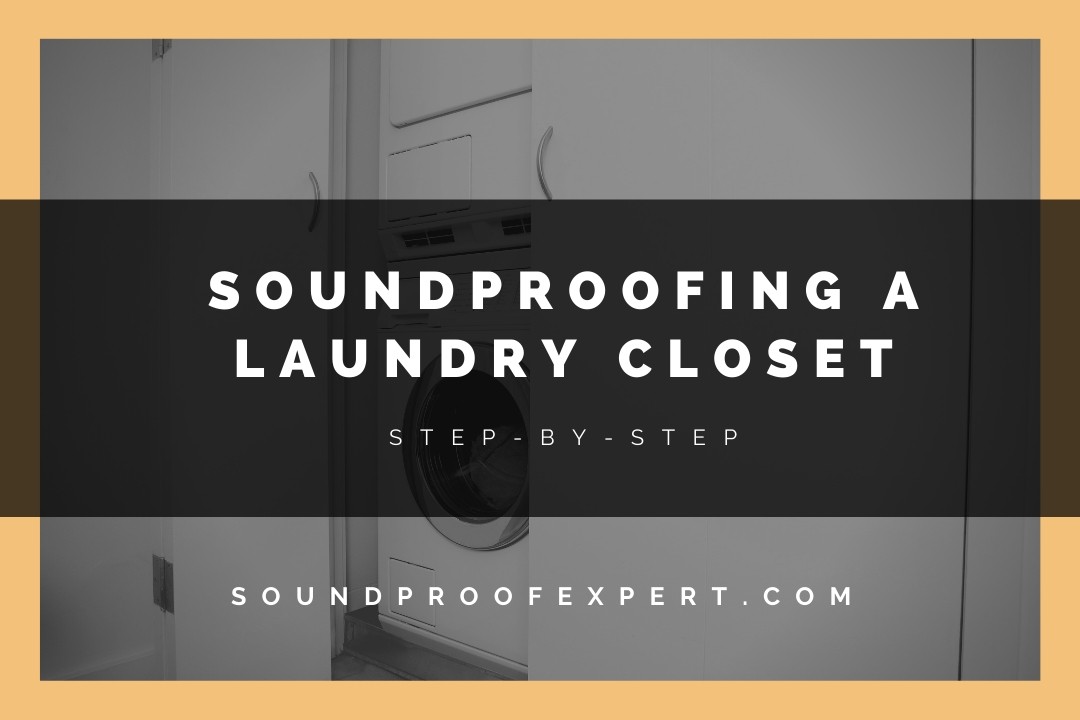
Laundry closets can be some of the loudest rooms in most homes, causing distress at any time of the day. If you’re forced to run it at night, then you understand the frustration.
The good news is that you can soundproof your laundry closet with all sorts of different techniques. You’ll cut back on the noise and your neighbors will be thankful too!
So, do you want to learn how to soundproof a laundry closet? Try these suggestions:
- Install sheets of mass-loaded vinyl, I recommend the Noise Grabbers from SoundproofingMLV.
- Get a solid core door filled with wood or metal.
- Try the Dense Dense Soundproofing Composite Pads from DEKIRU.
- Use a door sweep to block the sound coming from underneath, such as this one from Suptikes.
- Put dense rubber mats underneath the laundry machines, I recommend the XCEL antivibration PadsXCEL antivibration Pads.
Throughout this article, you’ll also learn about how you can apply each of these suggestions, how effective they are, and why soundproofing is different than sound dampening and absorption.
Soundproof a Laundry Closet: Step-by-Step
There are dozens of ways to soundproof your laundry closet, but it’s important to know the differences between each method.
Sound dampening only cuts down on the sound that comes through the surface. On the other hand, true soundproofing completely removes all sound going through walls, doors, and other surfaces.
Let’s check out the five best ways to soundproof a laundry closet in step-by-step guides.
Using Mass-Loaded Vinyl to Soundproof
Use mass-loaded vinyl sheets to stop sound from penetrating the walls of your laundry closet.
Start by clearing everything out of the room to make it easier for you to install the sheets. There shouldn’t be anything between the walls and the mass-loaded vinyl.
These sheets work the best since sound is cut out by dense, heavyweight materials.
Remove the drywall to expose the wooden structure and insulation. This step is crucial because it’s the best way to get the most out of MLV sheets.
However, you can place the sheets over the top of the drywall if you can’t remove the drywall.
Use wood staples, nails, and/or glue to attach the MLV sheets to the wood. Make sure that the sheets are held flat against the wall rather than wrinkling or leaving flaps hanging open.
Replace the drywall to cover the mass-loaded vinyl. You won’t notice a difference when it comes to the appearance of the wall, but it’ll completely remove the sound going in and out of the room.
Adding mass-loaded vinyl sheets inside the walls of your laundry closet will definitely cut out the majority of sound coming through, but you’ll also have to worry about the sound entering through the door.
For more information about soundproofing the door of your laundry room, proceed to the next section.
Install a Solid Core Door
Consider the price differences and effectiveness of using metal or wood as the core of your door. In most cases, doors that lead to rooms inside of a house have to use wooden cores.
Any door that leads to a place outside, such as the front door, can use metal cores if you choose so.
Remove the hinges of your door and set the old door aside.
You’ll need to keep the hinges for measurements to ensure that the new solid core door is a good size for your door frame. Check out this suggestion from Meridian Homes Inc. about how to choose a solid core door.
Install the new solid core door using the help of an assistant.
Most solid core doors are quite heavy compared to traditional hollow doors. You’ll need someone else to support the weight of the door while you drill in the screws through the hinges.
Now that you have mass-loaded vinyl in the walls of your laundry closet and a solid core door, you can proceed to add layers of dense soundproofing material wherever you see fit.
Check out the next section for installation tips.
Use Dense Soundproofing Composite Material
Look around the washing machine room to figure out where you want to place the pads. Most people put them under the floor (if you can remove the tiles) or in the ceiling if you have rooms upstairs.
While they’re not as common as the mass-loaded vinyl sheets, these pads are very useful if you have weird angles that sheets can’t get in.
Remove the drywall from the ceiling to expose the wood, insulation, or whatever other materials lie underneath. You can also line the top of the ceiling with the dense pads, but you probably won’t like the appearance of it.
Glue, staple, or drill the pads on the wooden structure of your ceiling. Center each pad to prevent any gaps around the edges. If you can’t fill an area with a dense pad, then use gap foam.
The Great Stuff Sound Sealant is an excellent choice to insulate the sound and temperature of the room.
Replace the drywall.
Much like the mass-loaded vinyl, the density and weight of these pads are enough to remove sound and prevent it from entering the laundry closet.
You might need to account for a slight lowering of the ceiling since the pads are about an inch thick.
Install Door Sweeps on Your Doors
Measure the size of your doors, including the width, length, and how high they sit off of the ground. You’ll need these three dimensions to know what size of a door sweep you should buy.
Door sweeps come in plenty of materials, but you should only choose rubber since it removes sound the best.
Remove your door from the hinges (you can perform this step at the same time that you’re installing the solid core door to check off both suggestions).
Line the top of the door sweep with the bottom of the door and mark the pilot holes for the screws. Drill those holes with bits.
Attach the door sweep and drill it in place. You can use Loctite to secure the screws and prevent them from loosening from excess use of the laundry room door. It’ll allow you to open and close it without having to worry about them bending or splintering the wood.
Get Rubber Mats For Your Laundry Machines
Rubber mats are quite a simple concept, though they’re not entirely necessary to soundproof a room.
If your laundry machines or dryer vibrate when they’re running, then placing rubber mats underneath them will stop the sound from transferring through your floors, walls, and doors.
You can also use the same dense soundproofing composite pads from earlier in the article. You’ll need to secure them to the floor with glue, Velcro, or double-sided tape to prevent them from moving around.
Note: Using rubber mats will cut down on the sound, but if your laundry machines are on carpet, you might experience issues. When rubber warms up it can bleed ink into the fabric, causing stains.
Conclusion
Soundproofing your laundry room is a great way to get peace of mind, a quieter home, and less stress when it’s time to wash your clothes.
It’s fairly inexpensive to soundproof washer closets compared to other home renovations, but you might need to hire a professional to help you remove the drywall or install the solid core door in this small space.
Also, make sure your washer is not abnormally noisy.
Here’s a quick recap of the post:
- Density and mass are required to remove sound completely.
- Using solid core doors and door sweeps will soundproof the doorframe.
- Apply mass-loaded vinyl sheets and soundproofing composite pads on the walls, floors, and ceiling.
- Rubber mats will quiet the sound of vibrating laundry machines.

Hi Jim
i have a problem with front loading dryer noise from my neighbour’s dryer located (facing me, solitary , on a concrete floor) in an outside garage on my property boundary. Used daily at exactly the time you step out to use your own property and garden. Garage is constructed of thin metal on a wooden frame on a concrete pad, and is a large double garage that is empty and with no shelves or fittings at all. Garage is functioning like a stereo speaker amplifying the vibration and dispersing it in an arc like a megaphone over 30m or more in my property, and loudest further away. The sound does seem to come forwards out of the front of the machine moreso than from the rear? Its not an option to sound proof the garage. My concept is ask the neighbour would she consent to placing this appliance within a purpose built sound-proofed cabinet or cupboard. Ive learned that most dryers may have front vents, but can usually (mostly almost) be converted into back-venting. This dryer currently isnt vented at all, the steam just goes into the garage, so if enclosed in a cupboard id need to vent. Do you have any guidance or comments regarding construction of a purpose built ” cupboard to place this in? Here in NZ people are starting to place their laundry appliances outside in free standing garages where the sound impacts neighbours . Noise-control rules govern decibels, and dont seem to adequate enforce around nuisance noise due to vibration and frequency….. regards, L